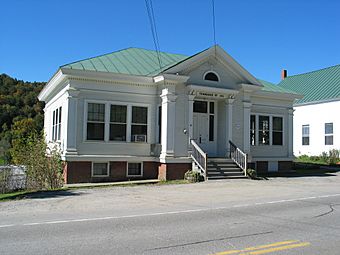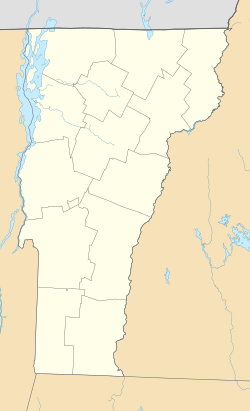Tunbridge Village Historic District facts for kids
Quick facts for kids |
|
|
Tunbridge Village Historic District
|
|
 |
|
| Location | Roughly, along VT 110 and adjacent rds. including Town Rd. 45 and Spring and Stafford Rds., Tunbridge, Vermont |
|---|---|
| Area | 115 acres (47 ha) |
| Built | 1800 |
| Architectural style | Gothic Revival, Greek Revival, Federal |
| NRHP reference No. | 94000635 |
| Added to NRHP | June 24, 1994 |
The Tunbridge Village Historic District is a special area in Tunbridge, Vermont. It shows what a small village looked like in the early 1800s. This historic district stretches along Vermont Route 110. It was once a busy farming village. Most of its buildings were built a long time ago. In 1994, this area was added to the National Register of Historic Places. This means it is an important place to protect because of its history.
Contents
Exploring Tunbridge's Historic Past
The village of Tunbridge was officially started in 1761. People began to settle here in the 1780s. The first buildings were a sawmill and a gristmill. These were built in 1785 next to the First Branch of the White River. A sawmill cuts logs into lumber. A gristmill grinds grain into flour.
How Tunbridge Village Grew
Tunbridge was a good place for farming. It had rich, flat land near the river. This helped it become an important farming center. In 1820, a brickyard opened. This made bricks for many local buildings. The village grew steadily.
The Impact of Railroads
During the 1800s, railroads were built across the country. However, the main railroad lines did not come through Tunbridge. This meant fewer new buildings were built. But the village still thrived. It stayed connected to farming. It was also close to a train station in nearby Royalton.
The Famous Tunbridge World's Fair
A very important event for Tunbridge is the Tunbridge World's Fair. It started in 1847. This fair has been held in the village's fairgrounds since 1875. It is still a big event today. Because of its history, most of the buildings in the district were built before 1840.
What You Can See in the District
The Tunbridge Village Historic District covers most of the old village. It mainly follows Vermont Route 110. This road is the main route along the First Branch White River. The district starts at Howe Lane (Town Highway 45) in the south. It goes past Spring Road in the north.
Notable Buildings and Styles
You can find many buildings on side streets too. These include Strafford Road and Spring Street. On Spring Street, you can see the Hayward and Kibby Mill and the Mill Covered Bridge. Most buildings are simple wooden houses. They are built in the Federal or Greek Revival styles. Some houses have later Gothic and Italianate features. A few are even made of brick.
Public Spaces and the Fairgrounds
The village also has several public buildings. There are also a few churches. The fairgrounds are on the west side of Vermont 110. They have many well-preserved buildings from the 1800s. These buildings show what the fair was like long ago.



